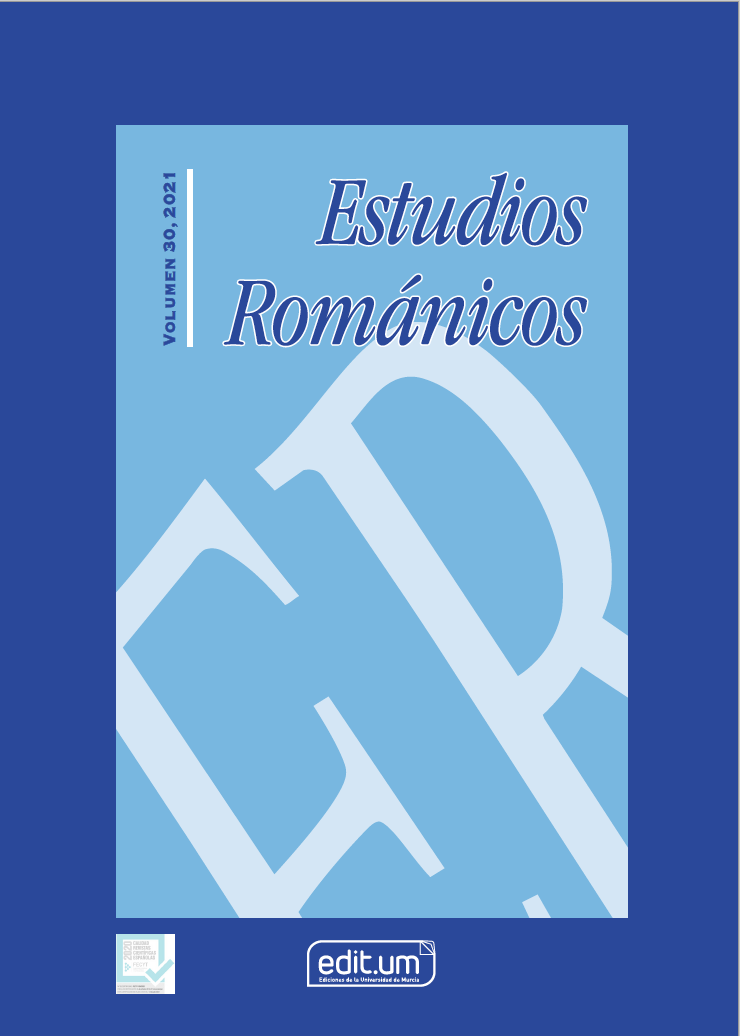Intensification in Occitan folktales
Abstract
This study offers an initial exploration of the intensification strategies attested in a written corpus of 162 Occitan folktales (north-east and south-west Lengadocian varieties). Although, overall, the pool of available resources corresponds to ordinary Occitan usage, the deployment of the strategies also reflects the particular conditions surrounding the storytelling and (cultural) transmission of folktales. Intensification is used to strengthen both the audience’s immersion in the narrative, and the cultural and social cohesion of the community in which the stories are told.
Downloads
-
Abstract508
-
pdf (Español (España))493
References
AARNE, Antti (1961): The Types of the Folktale: A Classification and Bibliography, translated and enlarged by Stith Thompson. Helsinki: Suomalainen Tiedeakatemia.
ALIBÈRT, Loís (1976): Gramatica occitana segon los parlars lengadocians. Montpelhièr: Centre d’Estudis Occitans.
ALLAN, Rutger (2018): “Construal and immersion”, Peter Meineck; William Short; Jennifer Devereux (eds.). The Routledge Handbook of Classics and Cognitive Theory. Abingdon: Routledge.
BACH, Xavièr (2020): “Morfosemantica dels augmentatius en occitan del Lengadòc”, Jean-François Courouau; David Fabié (eds.). Fidelitats e dissidéncias/Fidélités et dissidences. Actes du XIIe congrès de l’Association Internationale d’Etudes Occitanes. Toulouse: Section française de l’Association internationale d’études occitanes, 115-120.
BAKKER, Egbert (1993): “Discourse and performance: Involvement, visualization and ‘presence’ in Homeric poetry”. Classical Antiquity 12(1): 1-29.
BARRETT, Justin; NYHOF, Melanie (2001): “Spreading of non-natural concepts: The role of intuitive conceptual structures in memory and transmission of cultural materials”. Journal of Cognition and Culture. 1, 69-100.
BARRETT, Justin; BURDETT, Emily Reed; PORTER, Tenelle (2009): “Counterintuitiveness in Folktales: Finding the Cognitive Optimum”. Journal of Cognition and Culture. 9: 271–287.
BRU, Josiane (2014): Andrieu Lagarda: Les Secrèts de las Bèstias. Pau: Letras d’Oc.
BRU, Josiane; EYGUN, Jean (2019): Contes d’Aubrac recueillis par Marie-Louise Ténèze. Pau: Letras d’Òc.
ESHER, Louise (2020): “Grammaticalisation et valeurs pragmatiques des expressions signifiant un peu en français et en occitan”, Mercedes Banegas Saorin; Jean Sibille (eds). Entre francisation et démarcation : Usages hérités et usages renaissantistes des langues régionales de France. Paris: L’Harmattan, 61-78.
GARCIA-PAJE, Mario (2008): “La comparativa de intensidad: la función del estereotipo”. VERBA. 35: 143-178.
JAUBERT, Anna (2008): “Dire et plus ou moins dire. Analyse pragmatique de l'euphémisme et de la litote”. Langue française. 160(4), 105-116.
LEVERAGE, Paula (1999): The Chanson de Geste and Memory. Tesis doctoral, University of Toronto.
MARGERIE, Hélène (2007): “From downgrading to (over) intensifying: A pragmatic study of English and French”, Istvan Kecskes; Laurence Horn (eds.). Explorations in pragmatics: Linguistic, cognitive, and intercultural aspects. Berlin: Mouton de Gruyter, 287-311.
MPOULI, Suzanne; GANASCIA, Jean-Gabriel (2017): “Another Facet of Literary Similes: A Study of Noun+Colour Term Adjectives”. Corela [En ligne]. HS-21.
NORENZAYAN, Ara; ATRAN, Scott; FAULKNER, Jason; SCHALLER, Mark (2006): “Memory and mystery: the cultural selection of minimally counterintuitive narratives”. Cognitive Science. 30: 531-553.
OLIVIERI, Michèle; SAUZET, Patrick (2016): “Southern Gallo-Romance (Occitan)”, Adam Ledgeway; Martin Maiden (eds.). The Oxford Guide to the Romance Languages. Oxford: OUP, 319-349.
ROBERTS, Richard; KREUZ, Roger (1994): “Why Do People Use Figurative Language?”. Psychological Science. 5(3),159-163.
ROMERO, Clara (2015): “À quoi compare-t-on pour intensifier ? Analyse du comparant dans les comparaisons d’intensité stéréotypées ou inventives”, Krystyna Wróblewska-Pawlak; Anna Kieliszcyk (eds.). L'intensification et ses différents aspects. Varsovie: Presses de l’Université de Varsovie, 133-152.
ROMERO, Clara (2017): L’intensité et son expression en français. Paris: Ophrys.
UTHER, Hans-Jörg (2004): The Types of International Folktales: A Classification and Bibliography. Based on the system of Antti Aarne and Stith Thompson. Helsinki: Suomalainen Tiedeakatemia.
Copyright (c) 2021 Estudios Románicos

This work is licensed under a Creative Commons Attribution-NonCommercial-ShareAlike 4.0 International License.
Las obras que se publican en esta revista están sujetas a los siguientes términos:
1. El Servicio de Publicaciones de la Universidad de Murcia (la editorial) conserva los derechos patrimoniales (copyright) de las obras publicadas, y favorece y permite la reutilización de las mismas bajo la licencia de uso indicada en el punto 2.
2. Las obras se publican en la edición electrónica de la revista bajo una licencia Creative Commons Reconocimiento-NoComercial-SinObraDerivada 3.0 España (texto legal). Se pueden copiar, usar, difundir, transmitir y exponer públicamente, siempre que: i) se cite la autoría y la fuente original de su publicación (revista, editorial y URL de la obra); ii) no se usen para fines comerciales; iii) se mencione la existencia y especificaciones de esta licencia de uso.
3. Condiciones de auto-archivo. Se permite y se anima a los autores a difundir electrónicamente las versiones pre-print (versión antes de ser evaluada) y/o post-print (versión evaluada y aceptada para su publicación) de sus obras antes de su publicación, ya que favorece su circulación y difusión más temprana y con ello un posible aumento en su citación y alcance entre la comunidad académica. Color RoMEO: verde.












